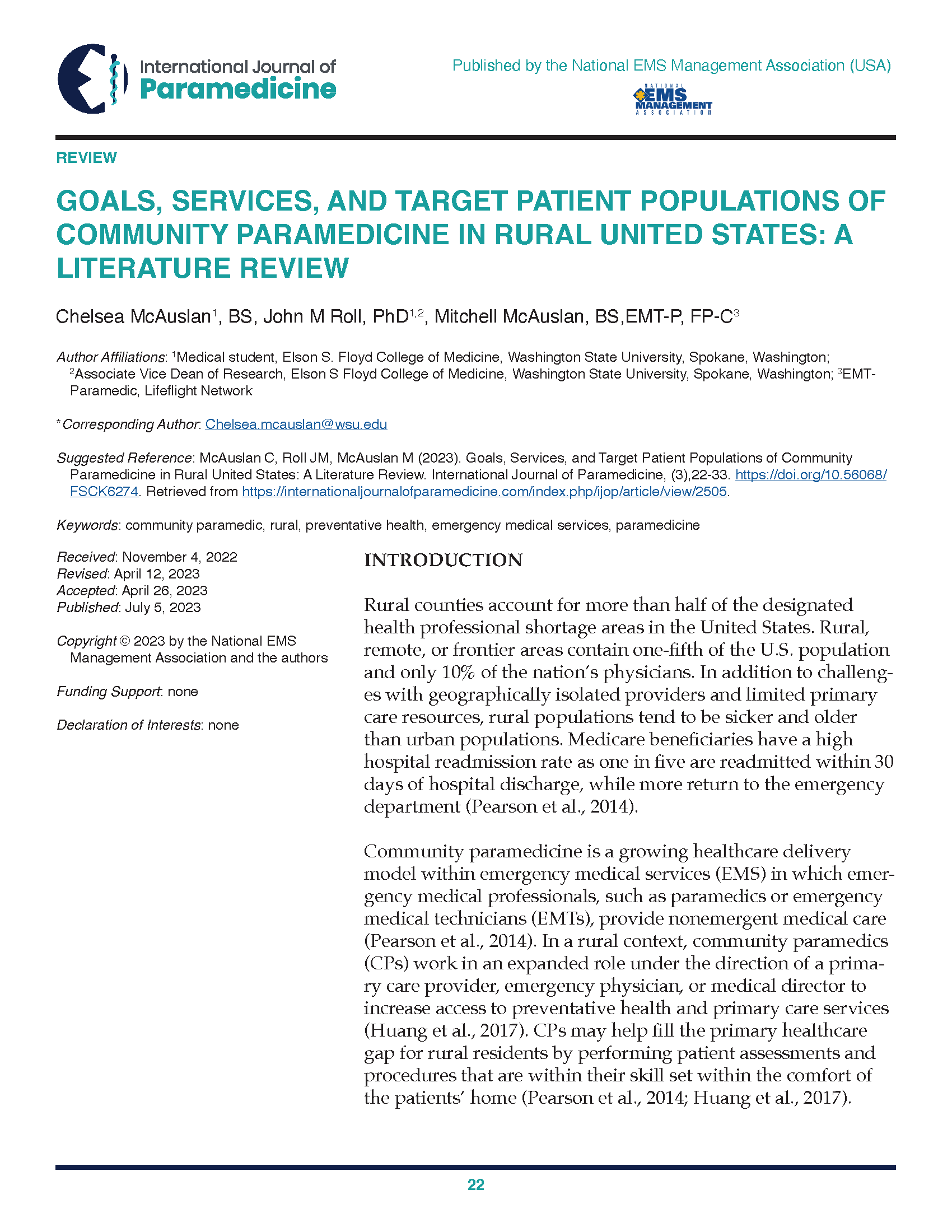Goals, Services, and Target Patient Populations of Community Paramedicine in Rural United States A Literature Review
Main Article Content
Abstract
Introduction: Rural areas contain one-fifth of the US population and only 10% of the nation’s physicians. Community paramedicine (CP) is a growing healthcare delivery model in which emergency medical personnel provide non-emergent medical care. Community paramedics may help fill the primary healthcare gap for rural residents. This literature review provides an overview of the common goals, services, target populations, and setbacks of rural CP programs in the US.
Methods: A systematic search following PRISMA protocols was completed on PubMed and Google scholar using the search terms: “community paramedicine/paramedic” and “rural, remote, frontier” between 2000-2021.
Results: Rural CP program goals are to aid patients in chronic disease management and reduce emergency department visits, hospital admissions/readmissions, and healthcare costs. Programs target services toward patients who are chronically ill, post-hospital discharge, and frequent EMS users.
Conclusion: CP provision of preventative and primary care services has improved health outcomes for patients with chronic disease. Programs report cost savings for the healthcare payer and patient and a reduction in ED transports and hospital readmissions. The problems identified are acquiring sustainable funding to develop CP programs and reimburse CP services, lack of consistency between CP scope of practice and educational requirements across states, role tensions with other healthcare professions, and lack of research about the safety of CP programs for patients. Future research is needed to investigate patient outcomes secondary to CP preventative and primary care services, which may identify if CPs are an effective means of helping fill the primary care gap for rural communities.
Article Details

This work is licensed under a Creative Commons Attribution-ShareAlike 4.0 International License.
Publishing in IJOP allows authors to keep their copyright while giving IJOP unrestricted copyright permissions. Articles published in IJOP use Creative Common Attribution 4.0 International (CC BY-ND 4.0) licensing. This license requires that re-users give credit to the creator. It allows re-users to copy and distribute the material in any medium or format in unadapted form only, even for commercial purposes. Additional terms apply and can be accessed here.
Publishing in IJOP also allows authors to have contracts for non-exclusive distribution of the Journal's published version of the article, such as posting to an institutional repository or publication in a book, on the condition that the original publication in the original layout format in IJOP is retained and acknowledged.
We permit and encourage authors to post the articles they published in IJOP on their affiliated websites. This helps share the information, encourages citation in other works, and promotes scholarly discourse in the spirit of open access.
References
Bennett, K. J., Yuen, M. W., & Merrell, M. A. (2017). Community Paramedicine applied in a Rural Community. The Journal of Rural Health, 34. https://doi.org/10.1111/jrh.12233
Choi, B. Y., Blumberg, C., & Williams, K. (2016). Mobile Integrated Health Care and Community Paramedicine: An emerging emergency medical services concept. Annals of Emergency Medicine, 67(3), 361–366. https://doi.org/10.1016/j.annemergmed.2015.06.005
Coffman, J., & Kwong, C. (2020, June 30). Left behind in California: Comparing community paramedicine policies across states. California Health Care Foundation. Retrieved June 6, 2021, from https://www.chcf.org/publication/left-behind-california-community-paramedicine-policies/
Freeman, V. A., Slifkin, R. T., & Patterson, P. D. (2009). Recruitment and retention in rural and Urban EMS. Journal of Public Health Management and Practice, 15(3), 246–252. https://doi.org/10.1097/phh.0b013e3181a117fc
Gregg, A., Tutek, J., Leatherwood, M. D., Crawford, W., Friend, R., Crowther, M., & McKinney, R. (2019). Systematic Review of Community Paramedicine and EMS Mobile Integrated Health Care Interventions in the United States. Population Health Management, 22(3), 213–222. https://doi.org/10.1089/pop.2018.0114
Huang, Y.-H., Ma, L., Sabljak, L. A., & Puhala, Z. A. (2018). Development of Sustainable Community paramedicine programmes: A case study in Pennsylvania. Emergency Medicine Journal, 35(6), 372–378. https://doi.org/10.1136/emermed-2017-207211
Martin, A., & O'Meara, P. (2019). Perspectives from the frontline of two North American Community paramedicine programs: An observational, ethnographic study. Rural and Remote Health. https://doi.org/10.22605/rrh4888
Mosesso, V. N., Packer, C. R., McMahon, J., Auble, T. E., & Paris, P. M. (2003). INFLUENZA IMMUNIZATIONS Provided by Ems agencies : The MEDICVAX Project. Prehospital Emergency Care, 7(1), 74–78. https://doi.org/10.1080/10903120390937139
Myers, L., Carlson, P., Krantz, P., Johnson, H., Will, M., Bjork, T., Dirkes, M., Bowe, J., Gunderson, K., & Russi, C. (2020). Development and implementation of a Community Paramedicine Program in rural United States. Western Journal of Emergency Medicine, 21(5). https://doi.org/10.5811/westjem.2020.7.44571
O’Brien, Bridget C. PhD; Harris, Ilene B. PhD; Beckman, Thomas J. MD; Reed, Darcy A. MD, MPH; Cook, David A. MD, MHPE. Standards for Reporting Qualitative Research: A Synthesis of Recommendations. Academic Medicine 89(9):p 1245-1251, September 2014. | DOI: 10.1097/ACM.0000000000000388
O'Meara, P., Wingrove, G., & Nolan, M. (2018). Frontier and remote paramedicine practitioner models. Rural and Remote Health. https://doi.org/10.22605/rrh4550
Patterson, D. G., Coulthard, C., Garberson, L. A., Wingrove, G., & Larson, E. H. (2016). What is the potential of community paramedicine to Fill Rural Health Care Gaps? Journal of Health Care for the Poor and Underserved, 27(4A), 144–158. https://doi.org/10.1353/hpu.2016.0192
Pearson, K., Gale, J., Coburn, A., Croll, Z., & Shaler, G. (2016). Developing program performance measures for rural emergency medical services. Prehospital Emergency Care, 21(2), 157–165. https://doi.org/10.1080/10903127.2016.1218978
Pennel, C. L., Tamayo, L., Wells, R., & Sunbury, T. (2016). Emergency medical service-based care coordination for three rural communities. Journal of Health Care for the Poor and Underserved, 27(4A), 159–180. https://doi.org/10.1353/hpu.2016.0178
Steeps, R., Wilfong, D., Hubble, M., & Bercher, D. (2017). Emergency medical services professionals’ attitudes about community paramedic programs. Western Journal of Emergency Medicine, 18(4), 630–639. https://doi.org/10.5811/westjem.2017.3.32591

